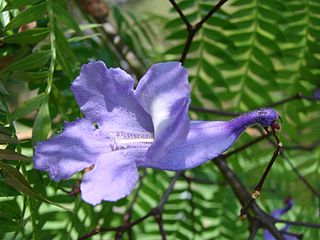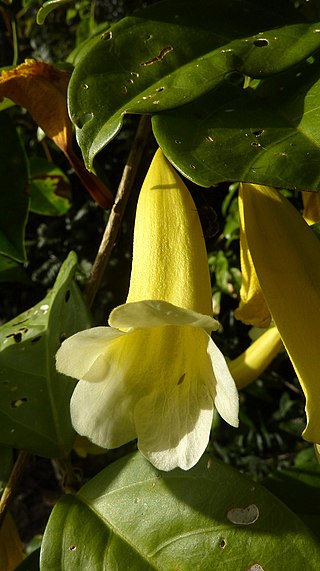
Bignoniaceae is a family of flowering plants in the order Lamiales commonly known as the bignonias or trumpet vines. It is not known to which of the other families in the order it is most closely related.

Jacaranda is a genus of 49 species of flowering plants in the family Bignoniaceae, native to tropical and subtropical regions of the Americas while cultivated around the world. The generic name is also used as the common name.

Bignonia is a genus of flowering plants in the family Bignoniaceae. Its genus and family were named after Jean-Paul Bignon by his protégé Joseph Pitton de Tournefort in 1694, and the genus was established as part of modern botanical nomenclature in 1753 by Carl Linnaeus. Species have been recorded from the southern USA, Central to most of South America.

Anemopaegma is a genus of flowering plants in the family Bignoniaceae. Species of Anemopaegma along with many other unrelated plants go by the name of catuaba.

Alwyn Howard Gentry was an American botanist and plant collector, who made major contributions to the understanding of the vegetation of tropical forests.

Luehea is a genus of trees in the family Malvaceae.

Hermannia is a genus of flowering plants in the mallow family, Malvaceae. It comprises at least 65 species with many more species as yet unresolved.

Markhamia is a genus of flowering plants in the family Bignoniaceae. The genus is named after Clements Markham.

Fockea is a genus of succulent scrubs native to Africa south of the equator. They are members of the Asclepiadoideae (milkweeds), a subfamily of the dogbane family Apocynaceae. Of the six recognized species, only the two most widely distributed extend north of southern Africa, with F. multiflora reaching as far north as Tanzania and F. angustifolia reaching to southern Kenya. Fockea are known as water roots, a reference to the bulbous caudex characteristic of most species, which is also edible in at least some species.

Amphilophium is a genus of flowering plants in the family Bignoniaceae, native to South America. Amphilophium crucigerum has escaped from cultivation elsewhere, and has become an invasive weed in Australia.
Pleonotoma is a genus of tropical, flowering lianas located in the family Bignoniaceae.
Xylophragma is a genus of flowering plants in the family Bignoniaceae, native to dry forests of Mexico, Central America, Trinidad and northern South America. They are lianas or scandent shrubs.

Sparattosperma is a genus of flowering plants belonging to the family Bignoniaceae.
Lundia is a genus of flowering plants belonging to the family Bignoniaceae.
Phyllarthron is a genus of flowering plants belonging to the family Bignoniaceae.
Stizophyllum is a genus of flowering plants belonging to the family Bignoniaceae.
Staelia is a genus of flowering plants belonging to the family Rubiaceae.
Sommera is a genus of flowering plants belonging to the family Rubiaceae.

Gaya is a genus of flowering plants belonging to the family Malvaceae. It has been classed in the Malvoideae subfamily and the Malveae tribe.
Martinella is a genus of flowering plants belonging to the family Bignoniaceae. It is a genus of Neotropical lianas within the tribe Bignonieae.












